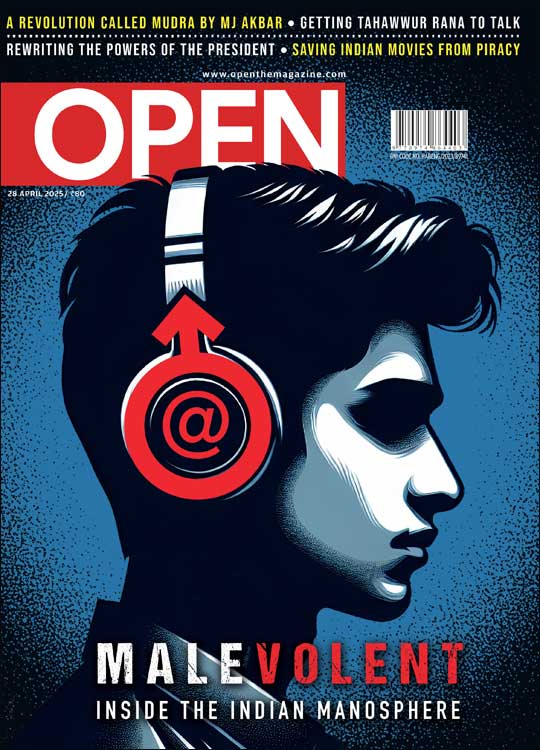What Powers the Dalit Resurgence
A new generation of Dalit leaders are challenging the old order and defying social hierarchies of the heartland
/wp-content/uploads/2017/06/Therebel1.jpg)
FILMMAKER STALIN K’S AWARD-WINNING 2007 documentary on untouchability, India Untouched, features a Varanasi priest, Batuprasad Sharma Shatri, who declares animatedly before the camera that only animals use intelligence while human beings fall back on ancient textbooks for answers about life. “Therefore, I believe in caste and untouchability,” he announces with a melodramatic flourish, dismissing the Indian Constitution as invalid. The same film lay bare multiple vignettes of caste-related violence and anguish: of a JNU Dalit student who narrates a harrowing experience of being discriminated by Brahmin roommates; of a Dalit politician in Kerala complaining of harassment by her former party colleagues, the Marxists, for breaking away to float a new party; of a Rajasthani Rajput family bragging about how they still use might to silence lower castes; and more of man’s caste-inspired crimes against man in the world’s largest democracy.
Such scant respect for rule of law isn’t just rhetoric. Their theories often sound like mellowed rants in comparison to what they practice. Decades after the abolition of untouchability, a majority of Dalits are still forced to do the most dehumanising jobs, denied opportunities and marginalised. A large section of the “broken people”, as Bhimrao Ambedkar called them, continues to be brutalised by others in the caste hierarchy, including the upper castes and the intermediaries. Statistics from the Government are startling: 4 Dalit women are raped every day in India. Two Dalits are killed every day; every 18 minutes there is an atrocity committed against a Dalit; two to three Dalit homes are burnt down daily. Worse, in more than 90 per cent of the cases, the perpetrators walk away with impunity.
Dalit leader Jignesh Mevani claims that assaults on Dalits have risen ever since the BJP was elected to power in 2014. But anti-Dalit attacks had been steadily on the rise even in the preceding years, rising 19 per cent in 2014 compared with a year earlier and 17 per cent in 2013 compared with 2012. According to the latest data available with the National Crime Records Bureau (NCRB), crimes against Dalits rose to 47,064 in 2014 from 39,408 in 2013. In Gujarat alone, rapes of Dalit women went up 500 per cent from 2001 to 2014. Professor Surinder S Jodhka, who has written extensively about the caste system, offers a raft of reasons for this marked rise in violence against Dalits, one of them being the assertion by a section of them who are ready to stand up for all. “The new generation of Dalits who are mobile and educated don’t see any justification for the caste system,” he notes, emphasising that “they are now extremely comfortable with their Dalitness.” Jodhka calls this phenomenon that has set in especially among second and third generation urban Dalits who also hold sway over the rural folk as “normalisation of the idea of citizenship”.
True, the times they are a-changin’. A section of youth among Dalits knows only too well that social equations in the countryside are changing swiftly. Having experienced city life where— despite hardship—anonymity has offered them dignity, they no longer want to see their parents, relatives and neighbours in the villages to be underlings. Galvanising young people from their communities that make up the broader entity called Dalit is the natural next step. However, the caste system is so deeply entrenched that Dalits who fight for their rights are increasingly coming under the threat of violence from upper castes fuelled by wounded pride. Dalits are fighting back regardless. Having managed recognition by all political parties, though not their redistributive rights such as quality education and healthcare, Dalits have for decades been on the path of staking their rightful claim as a force of 200 million people, as big as the population of Brazil. The change in the way this group—which accounts for more than 16 per cent of India’s population—has been reacting to injustice meted out to them is quicker than ever, thanks to the new generation armed with technology and urbanisation that has triggered dynamic social changes in the hinterland.
Recently in Saharanpur, Uttar Pradesh, a state where the BJP won a landslide victory in the Assembly polls in March, Dalits apparently took the law into their hands under the leadership of Bhim Army, led by a 30-year-old lawyer, Chandrasekhar, who is on the run after being declared ‘wanted’ for instigating violence against the upper-caste Thakurs. Skirmishes between the Dalits and the upper castes started on May 5th in Shabbirpur village of Saharanpur where an upper-caste youth was killed in violence that followed Dalits objecting to a procession that was being taken out to mark the birth anniversary of Rajput king Maharana Pratap. Later, Bhim Army members reportedly torched a number of vehicles after their request for holding a ‘mahapanchayat’ was turned down by the administration in the strife-torn district. Sambaiah Gundimeda of Azim Premji University— who is the author of Dalit Politics In Contemporary India—is excited by the emergence of new movements such as the Bhim Army, though he hastens to add that it should serve to deter anti-Dalit violence and not to promote violence against any castes. “I welcome Bhim Army. Dalits and other marginalised sections should have many more Bhim armies. The very presence of the Bhim armies should prevent the upper castes from committing violence against Dalits and other marginalised sections.” He is of the view that such political outfits have risen because mainstream political parties have failed to consistently take up issues related to the Dalits. “In any case, I am glad about the emergence of the new consolidations, for they bring in new ideas and fresh faces into public life,” he says.
It is not for the first time that Dalits have created conflicts in addition to resisting them. Yet, what sets the violence in Sahranpur apart from the ones of the 1980s and later is that it took place when the scale of economic dependence of Dalits on the upper castes has changed drastically from three decades earlier. Explains Dalit scholar Chandra Bhan Prasad: “In the post 1991 economic reforms era, Dalits have freed themselves from the clutches of upper caste landlords. Earlier they were largely dependent on working in the farmlands of upper castes for their incomes. But economic liberalisation offered them an opportunity to migrate from their respective areas for industrial work which would give them higher remuneration and an income without being dependent on landlords.” He goes on, “If you see the villages in north India now, there are no bullocks or ploughs to till the farmland.” Thanks to higher disposable incomes among a section of the youth, young Dalit boys also carry smart phones and ride Royal Enfields, he points out. It is here that jealousy triggers conflict. “In the past, an upper-caste person had to visit a Dalit hamlet with a stick in his hand to scare the entire community. Now even if they to resort to firing bullets, chances are there would be retaliation,” says Prasad.
“The city-born, new-generation Dalits are extremely comfortable with their Dalitness.” – Surinder S. Jodhka, author and academic
Economic freedom that liberalisation brought forth is being leveraged by these new Dalit forces to defy centuries-old caste norms and to strike back in violent ways. On July 11 last year, self-styled cow protectors thrashed seven Dalit youths in Una, Gujarat, before they were stripped, tied to a vehicle and thrashed in public view for about two hours. All the Dalits had done was what their ancestors had done since the beginning of the leather industry: skin dead cows. The protest was immediate and massive. As caste arrogance and concomitant violence rise, so do deep grievances and backlash. A video clip of the bestial treatment of the Dalits sparked violence and protest marches. Young leaders such as Mevani exhorted members of the community to refuse to skin cows. Angry crowds also dumped 30 carcasses in front of government offices in two Gujarat districts. They said they wouldn’t do their traditional work and demanded that the vigilantes do it instead, “If the cow is your mother, you do her last rites.”
“Dalits have always protested against atrocities and killings of their brethren. I still remember the violence that followed the Khairlanji massacre (the Maharashtra village where in 2006 Dalit farmer Surekha Bhotmange, her two sons and a daughter were brutally tortured and killed by a mob),” admits a BJP leader from the state, adding, “But in Una, the protests captured national imagination and found solidarity among Dalits across the country and pitch-forked Mevani to the national scheme of things. At that time, Mevani epitomised the new crop of educated young Dalits who can’t tolerate discrimination. Una was, without doubt, a turning point, coming as it did after the Rohith Vemula incident in Hyderabad.” Vemula was a 27-year-old PhD scholar associated with the Ambedkar Students’ Association who committed suicide over alleged harassment by university authorities. The death triggered widespread condemnation of government apathy and mishandling of the situation by the university.
Atrocities against Dalits are also meant to show them their place when they ‘dare’ to behave as equals. Over the past decades, crimes against Dalits have gone up alongside a small section of them prospering thanks to reforms, access to education and economic opportunities. Both Jodhka and Gundimeda contend that young Dalits are more in search of economic goals than the social gains that their predecessors fought for. “They want jobs and they want resources,” says Jodhka, emphasising that with rural power centres disintegrating, “what happened in Saharanpur could have happened anywhere else, too”.
Gundimeda argues: “There is a section among the Dalits that has always wanted to organise the community on the lines of the Bhim Army. But owing to their respect for Ambedkar’s belief in parliamentary democracy they did not take that path. However, we need to understand the context in which the Bhim Army has emerged. Upper-caste Thakurs are always waiting for an opportunity to teach the Dalits a lesson. Saharanpur is not going to be first and last. Many more Saharanpurs will occur as long as Yogi Adityanath and BJP are in power.”
IT IS NOT the first time that Dalit politicos have talked the language of the fist. The Dalit Panthers movement in the 1970s— modelled initially on the Black Panthers of the US—were militant in their outlook. Its leaders courted controversy describing August 15, 1972, as ‘black independence day’. More importantly, they contributed to the rise of Dalit literature and renewed interest in the works of Jyotirao Phule who, SM Michael writes in his book Dalits in Modern India, ‘re-interpreted sacred religious literature… revolted against priest craft and the caste system and set on foot a social movement for the liberation of the sudras, ati sudras and women.’ In the south, the Dalit Panthers, which also initiated discussions about reformers such as Kuriakose Elias Chavara, Ayyankali and Iyothee Thass, was later renamed Viduthalai Chiruthaigal Katchi, an organisation that works towards Dalit causes, including entry into temples in south Indian states where Dalits are still disallowed.
“I welcome the Bhim Army. Dalits and other marginalised sections should have many more Bhim Armies.” – Sambaiah Gundimeda academic
Militant slogans against caste oppressors were brought to the centre-stage by a Dalit leader who was destined to become one of the most successful politicians as well. Kanshi Ram, born in Punjab, a state which is home to more Dalits than any other, made bold steps to organise the disadvantaged castes in government service in the early 1970s, and by 1978 launched BAMCEF, (The All-India Backward and Minority Communities Employees Federation). He had been with the Explosive Research and Development Laboratory in Pune when he came face to face with caste discrimination and then worked towards organising Dalits. He soon became deeply disenchanted with what he called the stooge culture of pro-Dalit Republican Party of India (RPI), and leaders from the community within the Congress. According to Sudhir Panwar, professor at Lucknow University, it was the age of Dalit leaders gaining position at the expense of their community. Kanshi Ram brandished his anti-upper caste credential like a badge of honour—he also relished the use of anti-upper caste slogans to popularise his new party, the Bahujan Samaj Party (BSP), as a counterweight to the Congress which had until then secured Dalit votes. One such slogan was: Tilak tarazu aur talwar, inko maro jute char (Brahmin, Baniya and Thakur, thrash them with shoes). Over the next few years, he also aggressively brought back discussions on the Poona Pact, a 1932 agreement that Mahatma Gandhi had with Ambedkar when the latter agreed to withdraw demands for separate constituencies for Dalits (then called depressed classes). He organised nationwide campaigns to attract attention to the Dalits’ plight and demands. Under the banner of the BSP, both Kanshi Ram and his close associate, Mayawati, began to contest polls against high-profile leaders. Though they were trounced initially, they soon realised the party was pulling in a decent chunk of total votes polled. That crucial strategies and poll-tieups took BSP to great electoral triumphs is a testament to the vitality of Indian democracy. Yet, under Mayawati in recent years, the BSP has become a shadow of what it used to be in Uttar Pradesh, especially after a resounding drubbing both in the 2014 Lok Sabha polls and the 2017 Assembly elections.
Gundimeda says that the emergence of the Bhim Army needs to be understood from the point of the simultaneous weakening of the BSP. “BSP’s failure at the recent electoral politics and Mayawati’s non-responsiveness in a dire context like this compelled the people to organise around the Bhim Army (in Saharanpur). Essentially it is the context that determined the consolidation of the Dalits behind Bhim Army,” he avers. Various Dalit leaders from Congress and BJP that Open spoke to also lashed out at the police across various states for their hesitation to include most crimes against Dalits under the provisions of the SC and ST (Prevention of Atrocities) Act, which would ensure stricter punishment.
Sudhir Panwar, meanwhile, is unconvinced about how long the Bhim Army can survive in the rough and tumble of UP politics. He submits that the slogans by the BSP in the 1990s and earlier were equally ferocious. “Mayawati had come down the same path, tapping the waning loyalty among Dalits towards the Congress,” he says. Gundimeda agrees that organisations such as Bhim Army cannot survive in the long run, because unlike extremist Hindus, Dalits are ideologically non-violent people. He anticipates that the upper castes will go after such groups with vehemence and, with the help of members of their caste in the state administration, inundate them with trumped-up charges. Incidentally, a disproportionately high number of undertrials awaiting justice in jails are Dalits, with Gujarat topping the list. “We have seen all this in Telangana before the bifurcation of Andhra Pradesh. Normal lives of activists will be disturbed forever, and their children will get little opportunity to continue their education. The net result is that the Bhim Army is an enormous cost—both men and material—for the Dalits,” says Gundimeda.
Several other analysts are also worried that Bhim Army may not have enough backing from a large section of Dalits, many of whom have made a big departure to vote for the BJP in the recent state elections. Dalits were expected to vote against the BJP because they were, arguably, the worst hit by last November’s demonetisation exercise as they work in the informal sector where cash was the sole mode of transaction. Many Dalits had to return home from cities after they lost their jobs. A large number of Dalits were also affected following restrictions on the sale of cows, leather and tanning industries. Yet, they voted overwhelmingly for the BJP.
Political loyalties may be redrawn, however, with Dalits falling prey to attacks from upper castes who are emboldened by the BJP win. As for the future of the Bhim Army, Radha Sarkar, a scholar at the London School of Economics who is working on a project on Dalits, concedes that social movements do have trouble sustaining themselves, from the Arab Spring to Occupy Wall Street to movements against corruption and state brutality in Latin America. “Movements are inevitably faced with questions on whether or not they should transition to electoral politics, and if so, how do they make the transition effectively. Would such a shift compromise their primary objectives? And if not become a political party, then how do they sustain themselves; how do they tackle questions of organisation and leadership?” she says, “Will a political party born out of a social movement be able to transform its momentum into electoral gains? This depends to some degree on the structure of the movement and the extent and sophistication of its internal organisation— does it have local-level mobilisations and grassroots activities?”
“I urge Dalit groups and youth to protest peacefully and think of a better fight for economic inclusion.” – Milind Kamble, chairman, Dalit Indian Chambers of Commerce and Industry
She feels Bhim Army has the makings of durability and a strong social base, since it began with the mission of education and runs some 300 schools for Dalit children in and around Saharanpur. According to her, one way to sustain and strengthen the movement is through coalitions with other Dalit groups and progressive political groups, both at the state and national levels. This can supply both a broad-based organisational structure and support base as well as some experience of electoral politics. “Indigenous mobilisation in Latin America demonstrates the potential of broader organisational linkages— these movements owe their endurance and successes in part to international alliances that exchanged ideas, experiences, and importantly, solidarity,” she adds.
“As long as there is rise in atrocities against Dalits, such organisations have a chance to stay afloat,” says a Congress leader based out of Delhi who rues that his party, which had produced great Dalit leaders of the stature of Babu Jagjivan Ram, has now lost trust among members of the community. In Tamil Nadu, caste supremacy of intermediate castes and OBCs means Dalits face a constant threat of fresh assaults. In Karnataka, untouchability and ban on temple entry are still the norm. In Maharashtra, Dalits are locked in continual standoff with OBCs. In Andhra Pradesh and Telangana, caste riots have lost their sting due to the high frequency of such incidents. In Gujarat and Madhya Pradesh, crimes against Dalits have seen a spike. In the cow belt and elsewhere, caste-related violence is rising rapidly. The situation is no different in Assam and Odisha.
Vijoo Krishnan, national joint secretary of the All India Kisan Sabha who interacts with Dalit groups across the country, feels that more Dalit leaders are keen to form a larger coalition to fight upper caste domination and parties that patronise them. Earlier, leaders of pro-Dalit groups have been inimical towards even the Left and were known for their rigid stance.
With more Dalits veering away from the BSP, such groups may perhaps come together to become a force to reckon with. After all, the BSP’s decline was its own doing. Mayawati centralising power was one reason. She also sidelined the material issues of Dalits, “in particular, those pertaining to land redistribution, education, and healthcare,” says Sarkar. “The BSP undertook only token land redistribution measures. Of the total title deeds distributed in UP till 2005, only 5.5 per cent was distributed under BSP governments (in alliance with others).” The BSP did not distribute any land between 2007 and 2012.
Unfortunately, for the majority of Dalits, organisations that represent their interests are still fractured. Some Dalit groups have come to represent the interests of a particular caste, a charge that has befallen on Bhim Army as well. What would unite disparate groups is their enthusiasm for purging old prejudices and building a new future for a section that has been marginalised for the longest time in history. Liberalisation threw up new opportunities for a section of them—like Milind Kamble, chairman of the Dalit Indian Chambers of Commerce and Industry, who has become a successful entrepreneur—but most Dalits are still excluded from a hierarchy that is still Brahminical and is obsessed with religious purity. Kamble believes that we are going through the last phase of atrocity on Dalits. “If you see in the US, the lynching of blacks increased in the 1960s, 70s and 80s. Finally they were liberated. It will be true in the Indian context too. More lynching incidents are being reported in recent times, because Dalits are on the verge of liberation. I only urge Dalit groups and youth to protest peacefully and think of a better fight for economic inclusion,” he says.
That is perhaps easier said than done in a country where political triumphs of nationalist parties are presumed to be a validation of old prejudices and where outlawed practices frequently resurface. Once upon a time, converting to Buddhism was considered the easy step to escape from the tentacles of caste hierarchy. Not any longer. For socio-economic conditions to change and for the annihilation of caste, such a step is barely adequate.
Stalin K’s film shows a scene from Madurai, Tamil Nadu, where Dalits have to dismount from their bicycle and carry their slippers in their hands ever time they pass by an upper caste neighbourhood. Whoever defies this ‘tradition’ invites trouble. At a time when such injustices persist and privilege is invariably passed off as merit, games that some people play to appropriate Dalit icons such as Ambedkar and Ayyankali smack of lazy intellectual posturing. Yet, what is heartening is that more people are ready to chant jai bhim, court trouble and fight on.
(With inputs from Kumar Anshuman )

/wp-content/uploads/2025/04/Cover-Manosphere.jpg)















More Columns
Political parties echo anti-Pakistan sentiment after Pahalgam massacre Open
Indus treaty first step as India plans major retaliation Rajeev Deshpande
April 24 - Sachin Day Aditya Iyer